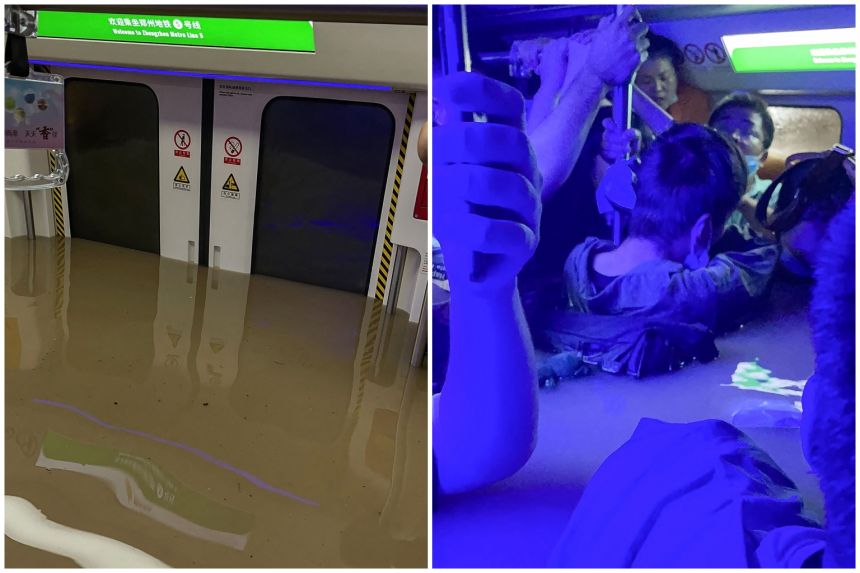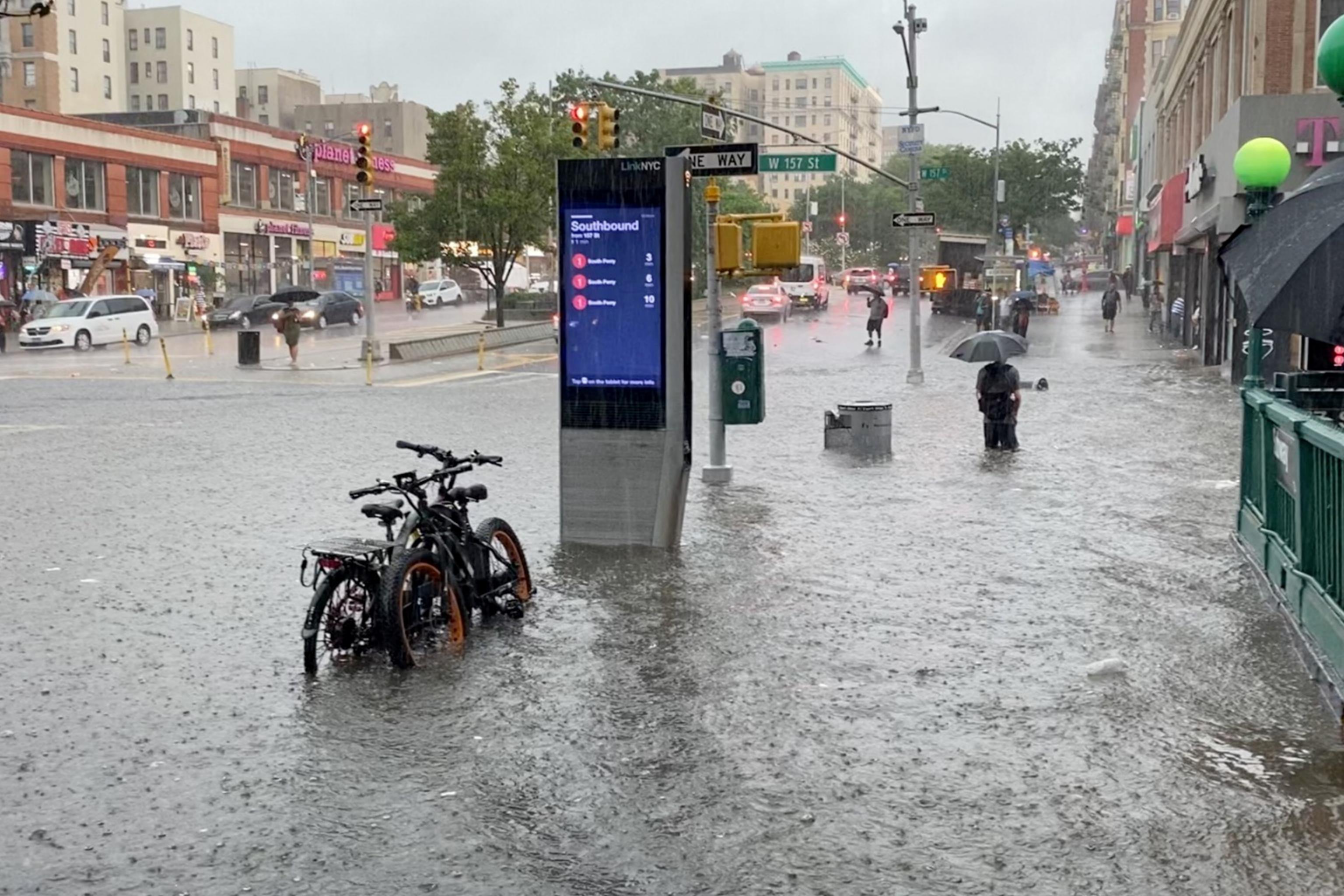Climate crisis could overwhelm underground railway systems, say experts
Sign up now: Get ST's newsletters delivered to your inbox

Commuters trapped inside a flooded subway carriage following heavy rains in Zhengzhou, China.
PHOTOS: COURTESY OF WEIBO/AFP
Follow topic:
NEW YORK (NYTIMES) - Terrified passengers trapped in flooded underground trains in Zhengzhou, China. Water cascading down stairways into the London Underground. A woman wading through murky, waist-deep water to reach a New York City subway platform.
Subways, the equivalent of underground railway systems around the world are struggling to adapt to extreme weather brought on by climate change. Their designs, many based on the expectations of another era, are being overwhelmed, and investment in upgrades could be squeezed by a drop in ridership brought on by the Covid-19 pandemic.
"It's scary," said Ms Sarah Kaufman, associate director of the Rudin Centre for Transportation at New York University. "The challenge is, how can we get ready for the next storm, which was supposed to be 100 years away but could happen tomorrow?"
Public transportation plays a critical role in reducing travel by car in big cities, reining in emissions that contribute to global warming. If commuters become spooked by images of inundated stations and start shunning subways for private cars, transportation experts say it could have major implications for urban air pollution and greenhouse gas emissions.
Some networks, such as London's and New York's, were designed and built starting more than a century ago. While a few, like Tokyo's, have managed to shore up their flooding defences, the crisis in China this week shows that even some of the world's newest systems (Zhengzhou's system is not even a decade old) can also be overwhelmed.
Retrofitting subways against flooding is "an enormous undertaking", said Mr Robert Puentes, chief executive of the Eno Centre for Transportation, a non-profit think-tank with a focus on improving transportation policy.
"But when you compare it to the cost of doing nothing, it starts to make much more sense," he said. "The cost of doing nothing is much more expensive."
Mr Adie Tomer, a senior fellow at the Metropolitan Policy Programme of the Brookings Institution, said subways and rail systems help to fight sprawl and reduce the amount of energy people use. "Subways and fixed rail are part of our climate solution," he said.
The recent flooding is yet another example of the kind of extreme weather that is consistent with changing climate around the world.
Just days before the China subway nightmare, floods in Germany killed some 160 people. Major heatwaves have brought misery to Scandinavia, Siberia and the Pacific North-west in the United States. Wildfires in the American West and Canada sent smoke across the continent this past week and triggered health alerts in cities like Toronto, Philadelphia and New York City, giving the sun an eerie reddish tinge.
Flash floods have inundated roads and highways in recent weeks, as well. The collapse of a portion of California's Highway 1 into the Pacific Ocean after heavy rains this year was a reminder of the fragility of the nation's roads.
But more intense flooding poses a particular challenge to ageing subway systems in some of the world's largest cities.
In New York, the Metropolitan Transportation Authority has invested US$2.6 billion (S$3.6 billion) in resiliency projects since Hurricane Sandy swamped the city's subway system in 2012, including fortifying 3,500 subway vents, staircases and elevator shafts against flooding. Even on a dry day, a network of pumps pours out about 14 million gallons (53 million litres), mainly groundwater, from the system. Still, flash flooding this month showed that the system remains vulnerable.
"It's a challenge trying to work within the constraints of a city with ageing infrastructure, along with an economy recovering from a pandemic," said Mr Vincent Lee, associate principal and technical director of water for Arup, an engineering firm that helped upgrade eight subway stations and other facilities in New York after the 2012 storm.
London's sprawling Underground faces similar challenges.
"A lot of London's drainage system is from the Victorian Era," said Mr Bob Ward, policy director at the Grantham Research Institute on Climate Change and the Environment in London. And that has a direct effect on the city's Underground system.
"It's simply not capable of dealing at the moment with the increase in heavy rainfall that we're experiencing as a result of climate change."
Meanwhile, the crisis in China this week shows that even some of the world's newest systems can be overwhelmed.
As Dr Robert Paaswell, a professor of civil engineering at City College of New York, put it: "Subways are going to flood. They're going to flood because they are below ground."
To help understand how underground flooding works, Professor Taisuke Ishigaki, a researcher at the Department of Civil Engineering at Kansai University in Osaka, Japan, built a diorama of a city with a bustling subway system then unleashed a deluge 280mm of rain in a single day.
Within minutes, floodwaters breached several subway entrances and started to gush down the stairs. Just 15 minutes later, the diorama's platform was under 2.4m of water - a sequence of events Ishigaki was horrified to see unfold in real life in Zhengzhou this week. There, floodwaters quickly overwhelmed passengers still standing in subway cars. At least 25 people died in and around the city, including 12 in the subway.

A person wades through the flood water near the 157th St. metro station in New York City, on July 8, 2021.
PHOTO: REUTERS
Ishigaki's research now informs a flood monitoring system in use by Osaka's sprawling underground network, where special cameras monitor above-ground flooding during heavy rainfall. Water above a certain danger level activates emergency protocols, where the most vulnerable entrances are sealed off (some can be closed in less than a minute) while passengers are promptly evacuated from the underground via other exits.
Japan has made other investments in its flooding infrastructure, like cavernous underground cisterns and flood gates at subway entrances. Last year, the private rail operator Tokyu, with Japanese government support, completed a huge cistern to capture and divert up to 4,000 tonnes of floodwater run-off at Shibuya station in Tokyo, a major hub.
Still, if there is a major breach of the many rivers that run through Japanese cities, "even these defences won't be enough", Professor Ishigaki said.
Mass transit advocates in the United States are calling for pandemic relief funds to be put towards public transportation. "The scale of the problems has become bigger than what our cities and states can address," said Ms Betsy Plum, executive director of the Riders Alliance, an advocacy group for subway and bus riders.
Some experts suggest another approach. With more extreme flooding down the line, protecting subways all of the time will be impossible, they say.
Instead, investment is needed in buses and bike lanes that can serve as alternative modes of public transportation when subways are flooded. Natural defences could also provide relief. In the Netherlands, Rotterdam has grown plants along its tramways, enabling rainwater to be soaked up by the soil, and reducing heat.
"During the pandemic you saw the way people got around on their bicycles, the most resilient, least disruptive, low cost, low carbon mode of transit," said Dr Anjali Mahendra, director of research at the World Resources Institute's Ross Centre for Sustainable Cities, a Washington-based think-tank. "We really need to do much more with connecting parts of cities and neighbourhoods with these bicycle corridors that can be used to get around."
Some experts question why public transportation needs to be underground in the first place and say that public transit should reclaim the street. Street-level light rail, bus systems and bicycle lanes are not just less exposed to flooding, they are also cheaper to build and easier to access, said Mr Bernardo Baranda Sepulveda, a Mexico City-based researcher at the Institute for Transport Development, a transportation non-profit.
"We have this inertia from the last century to give so much of the available space above ground to cars," he said. "But one bus lane carries more people than three lanes of cars."

